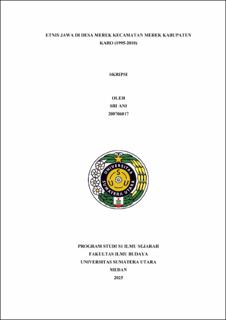| dc.description.abstract | This study discusses the process of the arrival of the Javanese ethnic group in Merek Village between 1995 and 2010 and the factors that influenced it, the forms of interaction and social adaptation of the Javanese ethnic group with the local community in Merek Village during the period 1995–2010, and the social and cultural impacts caused by the presence of the Javanese ethnic group in Merek Village during the period 1995 to 2010. This study aims to understand the process of the arrival of the Javanese ethnic group in Merek Village between 1995 and 2010 and the factors influencing it, the forms of social interaction and adaptation between the Javanese ethnic group and the local community in Merek Village during the period 1995–2010, and the social and cultural impacts caused by the presence of the Javanese ethnic group in Merek Village during the period 1995–2010. This study employs a qualitative research approach using the historical method. The historical method consists of four stages: heuristics, verification, interpretation, and historiography. In the heuristic stage, the data used is divided into two categories: primary data, which includes archives and official documents from the Central Statistics Agency (BPS), photographs, and documentary materials that provide an overview of activities and events that occurred, as well as transcripts of interviews with key informants who have direct experience; and secondary data, which includes articles, journal and thesis websites, e-books, and books. Based on the research findings, the process of the arrival of the Javanese ethnic group to Merek Village was driven by push factors from their place of origin, such as land scarcity and high land prices in Berastagi and Tebing Tinggi, as well as pull factors in Merek Village, including the availability of fertile land, a supportive climate, and a conducive social environment. Their arrival often occurred in a chain-like manner, influenced by the success of their predecessors in agriculture. In terms of social interaction and adaptation, the Javanese ethnic group established close ties with the Karo community through economic, social, and cultural activities, and endeavored to adapt to local traditions, including language use and participation in traditional ceremonies, while the Karo community also demonstrated an open attitude despite cultural challenges. The presence of the Javanese ethnic group has had a significant socio-cultural impact, enriching diversity, enhancing work ethic, and promoting cultural acculturation, evident in mutual influence in aspects of food, language, and traditional celebrations, thereby fostering social harmony among ethnic groups in Merek Village. | en_US |


